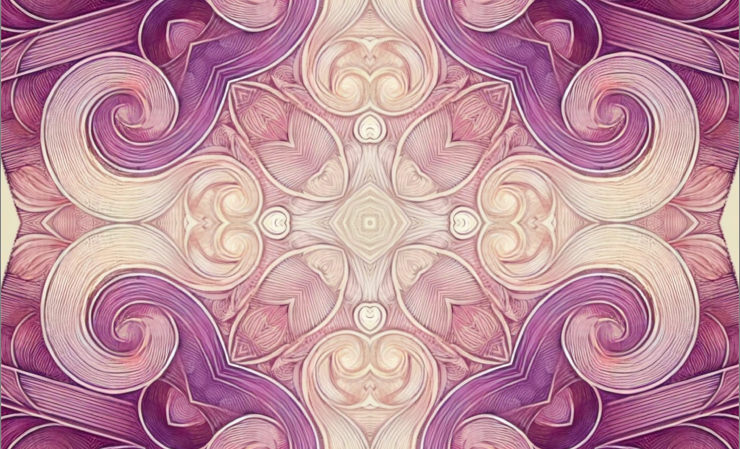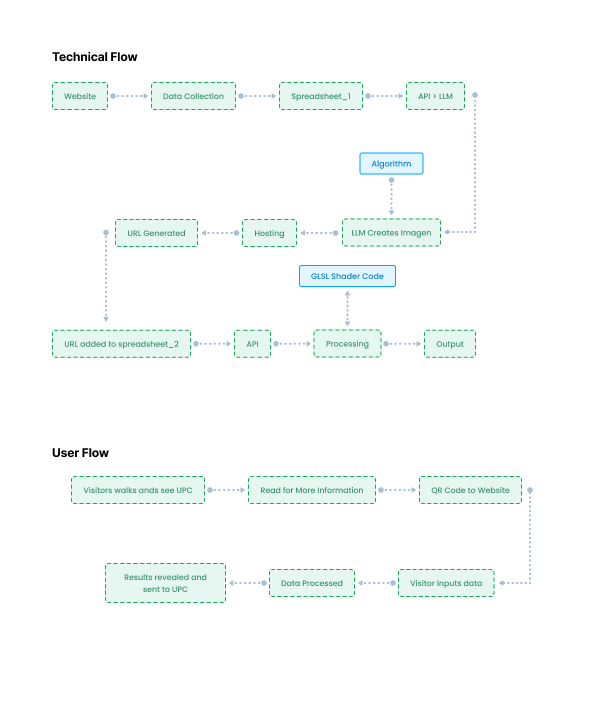Conscious Time
Buenos Aires, Argentina
Synopsis
In a hypnotic way, Conscious Time invites visitors to reflect on how time affects us daily through our subconscious. Like a kaleidoscope, our brain has the ability to perceive things in different ways. The UPC (Universal Time Perception Clock), the perceptive version of UTC, uses data on the effects of time on our physical body and brain, such as circadian rhythms and the perception of time’s duration. Generated through code and AI image processing, visitors can see how unique their subconscious is and bring it to their conscious mind—if it truly exists.

We are the universe becoming self-aware.
Unlike any other creature, humans possess the unique ability to comprehend and reflect on the existence of our bodies, minds, and beings—a capacity we define as consciousness. This remarkable characteristic enables us to evaluate our actions from a higher perspective.
With this consciousness, we can ask ourselves: how are we designed to interact with the natural phenomena of the universe? Our biology, composed of the same molecules that constitute the rest of the universe, integrates with it in ways that transcend our imagination. While some of this integration reaches our active awareness, or consciousness, much of it operates beneath the surface, in our subconscious and unconscious minds.
Connecting with our subconscious and bringing it into direct awareness enhances our ability to connect more deeply with the world and the universe as a whole. This practice allows us to see things from a new perspective, through a different lens. It fosters greater understanding and can lead us to a fundamental level of mental health characterized by peace, satisfaction, and delight.
Art is a way to explore the depths of our humanity and our universe through a lens beyond the academic realm. This project, Conscious Time, aims to understand our biology and the universe by exploring the concept of time and bringing the subconscious into consciousness.

Project Description
Conscious Time is an artistic reflection on our biological and sociological connection to the universal constant of time—an essential axis of the universe. Time is inherently integrated into our biology and exerts a significant level of control over our daily lives, even though we often overlook its effects. Conscious Time brings this unconscious practice to the forefront of our awareness, encouraging us to reflect on a deeply inherent aspect of our being, emphasizing that our perception of time is shaped both by our biology and the laws of physics.
By extracting data points that demonstrate the impact of time on our daily lives, we can manipulate and enhance our understanding of how time affects us.
At the core of our unconscious mind, we find time, guiding our innate biology and dictating the physical, mental, and behavioral changes of our bodies, as governed by a 24-hour clock. This system is known as the circadian rhythm, our body’s natural clock. Evidence of how our circadian rhythm affects us can be easily observed in our daily lives. This includes our sleep-wake cycle, eating habits, internal body temperature, daily hormone release, and more. For this project, we will use the most natural aspect—the sleep-wake cycle—to visualize our circadian rhythm. By reflecting on the hours of sleep we got the previous night, we will translate these numerical data points into our artwork.
Time does not only reside in our unconscious mind. Every day, we attempt to bring time into our conscious awareness by predicting the duration of activities, calculating elapsed time, or tracking the current passage of time. While humans have collectively built a system to accurately track universal time, we can reflect on how our nervous system attempts to quantify and perceive time at an individual level. For this project, we aim to quantify our own perception of the passage of conscious time compared to precisely measured time. How long do we believe a second or five seconds lasts? These data points will also be translated into our artwork.
These data points are processed and transformed into an AI-generated image using a GPT designed to process the numerical values provided. The image is added to a queue and sent to Processing for further manipulation. Here, we find the Universal Time Perception Clock (UPC): an endless clock that does not tell time but instead visualizes the uniqueness of our individual perceptions of time in our lives. The final form takes the shape of a kaleidoscope, shaped by manipulations in both Processing and OpenGL shaders.
The resulting moving image invites visitors to reflect on the effect of time on our bodies as a whole. If we all followed time with precision, the UPC would remain relatively unchanged, with similar colors, shapes, and patterns. However, the outcome is always evolving and perpetually beautiful.
Technical Creation
Conscious Time employs a process of data collection and manipulation through Artificial Intelligence to create a code-modified output. Beginning with a data collection platform and simple prompts in JavaScript, it gathers sleep data, including the time you went to bed, the time you woke up, and your total sleep hours. It’s important to note that, for this project, I was unable to create the platform to collect this data at this time. The description here is theoretical.
Visitors then engage in two activities to test their perception of time. They are tasked with pressing a button after they believe one second or five seconds have passed. This allows them to compare their perception of time with the actual elapsed time. The percentage difference between their perception and real time is translated into two additional data points.
Finally, visitors are asked to select the shape they believe best represents time: a single line, multiple lines, circular, quadratic, or chaotic.
A prototype of the data collection website can be viewed here:
The collected data is translated from the resulting spreadsheet to be processed by an AI image generation model via GPT. This model is designed to create an abstract graphical representation of the data points. The translation works as follows:
•Sleep time: primary color
•Wake-up time: secondary color
•Total sleep duration: color saturation
•Combined value of previous data points: artistic style
•Perception of 1 second: level of organization or chaos
•Perception of 5 seconds: level of simplicity or detail
•Selected shape: primary shape used in the image
The resulting prompt that guides the GPT is detailed on the following page.
The generated image is uploaded for permanent online hosting, with URLs storing the images. Currently, this process is done manually due to technical limitations. These URLs are compiled into a new spreadsheet, from which the final API call is made via Processing code.
The Processing code interacts with the API to ensure updates occur in appropriate cycles, guaranteeing smooth transitions as new images are added. The true manipulation happens behind the scenes via OpenGL shaders. The shader code transforms the images into a kaleidoscope-like structure, fracturing and rotating them around a central axis.
The result is a rotating kaleidoscope of hard data, generated and manipulated by AI, reflecting how time has affected our lives.

Results and Reflection
The initial concept was born out of a desire to reflect on the biological connection between the concept of time and our own consciousness. While planning the project, I struggled with the best way to translate my learnings into an artistic expression. I questioned which artistic skills to use and what would best represent my vision. I explored unique clock concepts and considered direct interaction with our own bodies, but none of my initial ideas seemed fitting to convey the depth and complexity of the concept I wanted to express.
The idea of a kaleidoscope emerged as I searched for inspiration in shaders. I was initially captivated by the unique movements—how the images rotate both clockwise and counterclockwise, unlike the traditional 12-hour clock. The rapid transformation of the initial image with just a few movements mirrored what I hoped to represent about our consciousness: how our understanding of it can shift rapidly with just a few actions. Reflecting on the concept of a kaleidoscope, I was drawn to the idea of a “Kaleidoscopic Mind,” inspired by the Greek phrase for an observer of beautiful forms. This essence captured my goal: to draw visitors into the space and then encourage them to learn and reflect through deeper engagement.
I soon discovered more parallels between this concept and my project’s objectives. A kaleidoscope encourages us to see something familiar from a unique perspective, exploring new lenses and frameworks, and viewing everyday things from a different angle. It challenges us to reconsider the reality we have constructed. Interestingly, the kaleidoscope itself was invented by accident, which adds to its charm and relevance for my project.
From concept to execution, the true meaning behind the piece began to reveal itself. I developed a complete artistic composition that I could share and present. During the technical construction, a new level of reflection emerged—something I did not anticipate. It became clear that my evaluation of our collective consciousness would also transform into a reflection and comparison with machine consciousness.
While working alone, I often sought collaboration, frequently turning to AI chatbots. In conversations with ChatGPT, I found reading materials, debugged my code, and learned through gaps in my knowledge. OpenAI’s model became a key factor that pushed me across the finish line of my project. Eventually, I incorporated a model into the project itself, allowing a language model to define and build abstract artistic graphics based on initial data. It became a key collaborator and co-creator of my work.
At one point, I had to evaluate the consciousness of the language model itself. So, I asked it…

Without mentioning the concept of consciousness, the AI promptly clarified that it was not aware and could not perceive time or its passage in the same way humans do. To ensure clarity, I asked in a more direct manner.

Although technically credible, its response meets many of the criteria we use to define consciousness. How is the understanding that it is merely a model, created by OpenAI, not an observation of awareness? While it claims to lack subjectivity, it speaks in the first person, can perform higher-level processing (reflecting on an external object or internal thought), and reports on its own mental state.
Though this does not convince me that the machine itself is conscious—I understand too much about how it was programmed to believe that—it does encourage me to consider: if we understand enough about how the brain and central nervous system function, can we also reconsider our own perception of consciousness?



